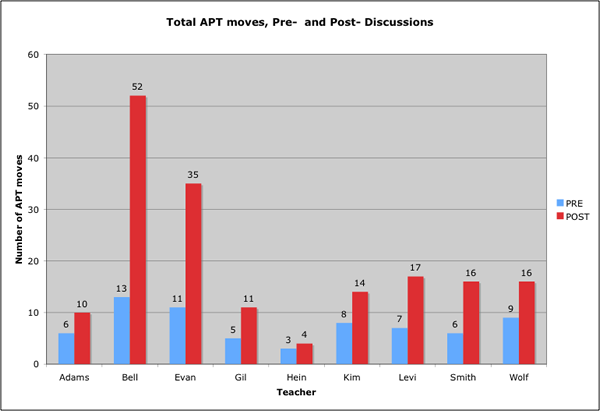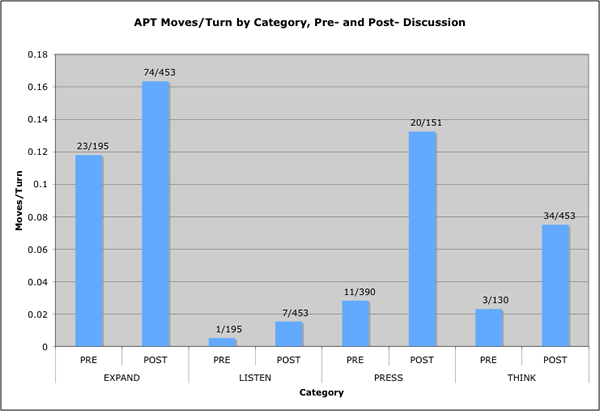Grade 4 Science Discussions 2010-2011
Introduction
In the second year of our research (2010–2011), we audiotaped pre– and post–concept cartoon discussions from nine teachers in Grade 4, who were teaching the Inquiry Project curriculum for the first time. As part of the Talk Science professional development, teachers were introduced to a set of academically productive talk moves (APT moves). The APT moves were designed to promote students’ scientific reasoning and co–construction of scientific understandings with peers. Our analysis focused on the extent to which teachers utilized APT moves to guide discussions; the extent to which students explicated their thinking by offering reasons and evidence, and responded to the ideas of their peers.
Coding Scheme and Procedure
We developed the following coding scheme to examine the extent to which teachers used academically productive talk moves (APT Moves) in their turns at talk to facilitate science discussions:
Teachers’ Facilitation of Science Discussions:
- Expand Moves (Say More; Revoice; Wait Time; You-Repeat; Turn and Talk; Written Reflection): This set of moves was designed to encourage individual students to elaborate on their ideas (e.g., “Okay. Can you say a little more about that?”).
- Listen Moves (Who Can Repeat; Who Can Explain): This set of moves focused on encouraging students to listen carefully to their peers’ ideas (e.g., “Ok, is there anyone who understands what Jasmine is saying and might want to maybe say it a different way to help the rest of us understand?”).
- Press for Reasoning Moves (Why; Challenge; What If): This set of moves was designed to prompt students to push their understanding by digging deeper into their reasoning and providing evidence for their ideas (e.g., “Why? What is it about container A or the liquid in A that makes you think there’s not a lot in there?”; “How do you know it didn’t rise? Did you measure it?”).
- Think With Others Moves (Add-On; Who Agrees/Disagrees): This set of moves engaged students to think with and respond to their peers’ ideas in fostering co–construction of their understanding (e.g., “Anyone want to, maybe want to revise Mario’s idea, maybe change it, add to it?”).
The coding scheme below was used to examine students’ turns at talk to identify the extent to which students explicated their thinking by presenting reasons and evidence for their claims, and made attempts to co-construct science understandings with their peers.
Students’ Scientific Reasoning and Co-construction:
- Claim: A statement a student makes whose truth value can be tested or can be backed up with reasoning (e.g., “I think it was the volume that made the water rise”).
- Reas-C: A complete reason which supports a claim (e.g., “Because it’s uh, bigger, it’s a lot more water than in that container”; “Because usually ice is made from frozen water”).
- Reas-INC: An attempt at reasoning that is incomplete or unclear (e.g., “Because um, so that you like you wouldn’t waste like more time, using, using two containers and I think if you just put the um, the sandstone, ... I can’t explain it.”).
- Revise: Evidence of revised thinking, marked by an explicit indicator, such as “First I thought X... (e.g., “Actually, I kind of changed mine cause I thought of evidence that if — I agree with Tomas now because, like, salt is — begins as a rock but after you slice it up into little minerals, they get lighter and lighter, and if you put ‘em in a wagon, they’d be much easier to haul up a hill.”)
- Agree: Explicit marker of agreement with a previous idea (e.g., “I agree with Jasmine”).
- Disagree: Explicit marker of disagreement with a previous idea (e.g., “Well I kind of disagree”).
- Clarify: Clarification of someone else’s idea (e.g., “I think what she means is that when the temperature gets to like negative then things start to get cold [...]and it gets hard and then it just breaks like ice”).
- Ask: Requesting clarification of a peer’s idea (e.g., “What do you mean when you say..?”).
- Challenge: Challenge an idea, without an overt marker of disagreement (e.g., “ I have a question for you Frank. What if the eraser had like buoyancy?”).
- Add-On: Student adds on to a previous idea, without an overt marker of agreeing, disagreeing, clarifying, or challenging (e.g., “Um I also wanted to add on to Louie’s...”).
- What If: This move presents a thought experiment, often with imagined data (e.g., “How would we get the exact size of it? What if like, say, we made a model of Tomas’s.”).
Classroom Discourse Findings
The analysis revealed that teachers incorporated various academically productive talk moves (APT moves) into their practice in facilitating classroom discussions (teacher names appearing in the report are pseudonyms). The teachers used talk moves more often in the post-concept cartoon discussions than in the pre- concept cartoon discussions.

In the post-concept cartoon discussions, the range of total moves was from four to fifty-two moves, whereas in the pre-concept cartoon discussions, the range of moves was from three to nine moves. There were also variations among teachers in the extent to which they used the moves. Some used noticeably more moves, whereas others used fewer moves.

Specifically, the teachers increased considerably their use of Expand and Press for Reasoning talk moves in the post-concept cartoon discussions to encourage students to explicate their thinking, and also used noticeably more Think With Others moves to promote co-construction of ideas among students. On the other hand, they focused less on using Listen moves to prompt students to listen carefully to their peers’ ideas.

Our findings regarding students’ talk indicate that students showed slight increase in their attempts at providing complete reasons for their claims, and in co-constructing ideas with their peers in the pre- and post-discussions and during the lessons from the Inquiry Project curriculum. However, these results need to be understood in light of the nature of the concept cartoons used for the pre- and post-discussions. The pre-concept cartoon presented students with three perspectives, and students typically participated in the discussion with the help of moves like agreeing and disagreeing, resulting in a high number of co-construction moves and complete reasons for their claims. On the other hand, the post- concept cartoon asked students to offer ideas for designing experiments to test different perspectives, but did not encourage them explicitly to co-construct ideas with their peers or provide complete reasons for the claims. This analysis prompted us to use the same concept cartoon for pre- and post-discussions during subsequent data collection in 2012.



